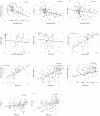Alterations of erythropoiesis in Covid-19 patients: prevalence of positive Coombs tests and iron metabolism
- PMID: 37780945
- PMCID: PMC10540584
- DOI: 10.1177/20406207231199837
Alterations of erythropoiesis in Covid-19 patients: prevalence of positive Coombs tests and iron metabolism
Abstract
Background: For more than 2 years medical practice has been dealing with the Covid-19 pandemic. Atypical symptoms, such as frostbites and acrosyndromes, have appeared, and autoimmune anemias (some of which with cold agglutinins) have been described.
Objectives: We planned to study the prevalence of positive direct Coombs tests (DCTs) and hemolytic autoimmune anemia in patients infected with Severe Acute Respiratory Syndrome Coronavirus 2 (SARS-CoV-2) and its correlation with complications, and then investigate the impact of the infection on iron metabolism.
Design: This is an observational, cross-sectional, single-center, exploratory study.
Methods: We obtained Coombs tests in a population of 179 infected patients at the CHU of Liège. We then studied iron metabolism in some of these patients, by measuring serum ferritin, erythropoietin (EPO), erythroferrone and hepcidin.
Results: We did not identify any case of autoimmune hemolysis. However, there was a 20.3% prevalence of positive DCT, mainly with IgG (91.7%). These patients, compared to DCT-negative patients, were not only more anemic and transfused, but also required more transfers to intensive care units and had longer hospital stays and mechanical ventilation. The pattern of anemia was consistent with the anemia of inflammation, showing elevated hepcidin and ferritin levels, while EPO and erythroferrone values were lower than expected at this degree of anemia. Erythroferrone was higher and Hb was lower in DCT-positive patients. Finally, we identified a correlation between iron parameters and complicated forms of infection.
Conclusion: Covid-19 patients suffered from inflammatory anemia with more severe forms of infection correlated to positive DCT status. This could potentially be of interest for future clinical practice.
Keywords: Coombs test; Covid-19; anemia; hemolysis; iron metabolism.
© The Author(s), 2023.
Conflict of interest statement
The author declares that there is no conflict of interest.
Figures
Similar articles
-
Erythroferrone and hepcidin as mediators between erythropoiesis and iron metabolism during allogeneic hematopoietic stem cell transplant.Am J Hematol. 2021 Oct 1;96(10):1275-1286. doi: 10.1002/ajh.26300. Epub 2021 Aug 24. Am J Hematol. 2021. PMID: 34310730 Free PMC article.
-
The role of hypoxia and inflammation in the regulation of iron metabolism and erythropoiesis in COVID-19: The IRONCOVID study.Am J Hematol. 2022 Nov;97(11):1404-1412. doi: 10.1002/ajh.26679. Epub 2022 Aug 15. Am J Hematol. 2022. PMID: 36215667 Free PMC article.
-
EPO-dependent induction of erythroferrone drives hepcidin suppression and systematic iron absorption under phenylhydrazine-induced hemolytic anemia.Blood Cells Mol Dis. 2016 May;58:45-51. doi: 10.1016/j.bcmd.2016.02.005. Epub 2016 Feb 19. Blood Cells Mol Dis. 2016. PMID: 27067488
-
Hepcidin and Anemia: A Tight Relationship.Front Physiol. 2019 Oct 9;10:1294. doi: 10.3389/fphys.2019.01294. eCollection 2019. Front Physiol. 2019. PMID: 31649559 Free PMC article. Review.
-
Anemia and iron metabolism in COVID-19: a systematic review and meta-analysis.Eur J Epidemiol. 2020 Aug;35(8):763-773. doi: 10.1007/s10654-020-00678-5. Epub 2020 Aug 20. Eur J Epidemiol. 2020. PMID: 32816244 Free PMC article.
Cited by
-
Chronic Obstructive Pulmonary Disease and COVID-19: The Impact of Hematological Biomarkers on Disease Severity and Outcomes.J Clin Med. 2025 Apr 17;14(8):2765. doi: 10.3390/jcm14082765. J Clin Med. 2025. PMID: 40283596 Free PMC article. Review.
References
LinkOut - more resources
Full Text Sources
Research Materials
Miscellaneous



